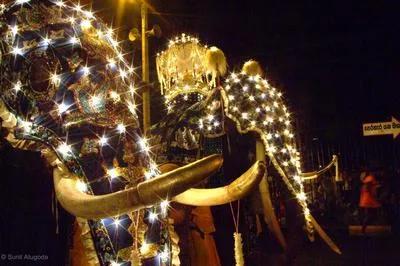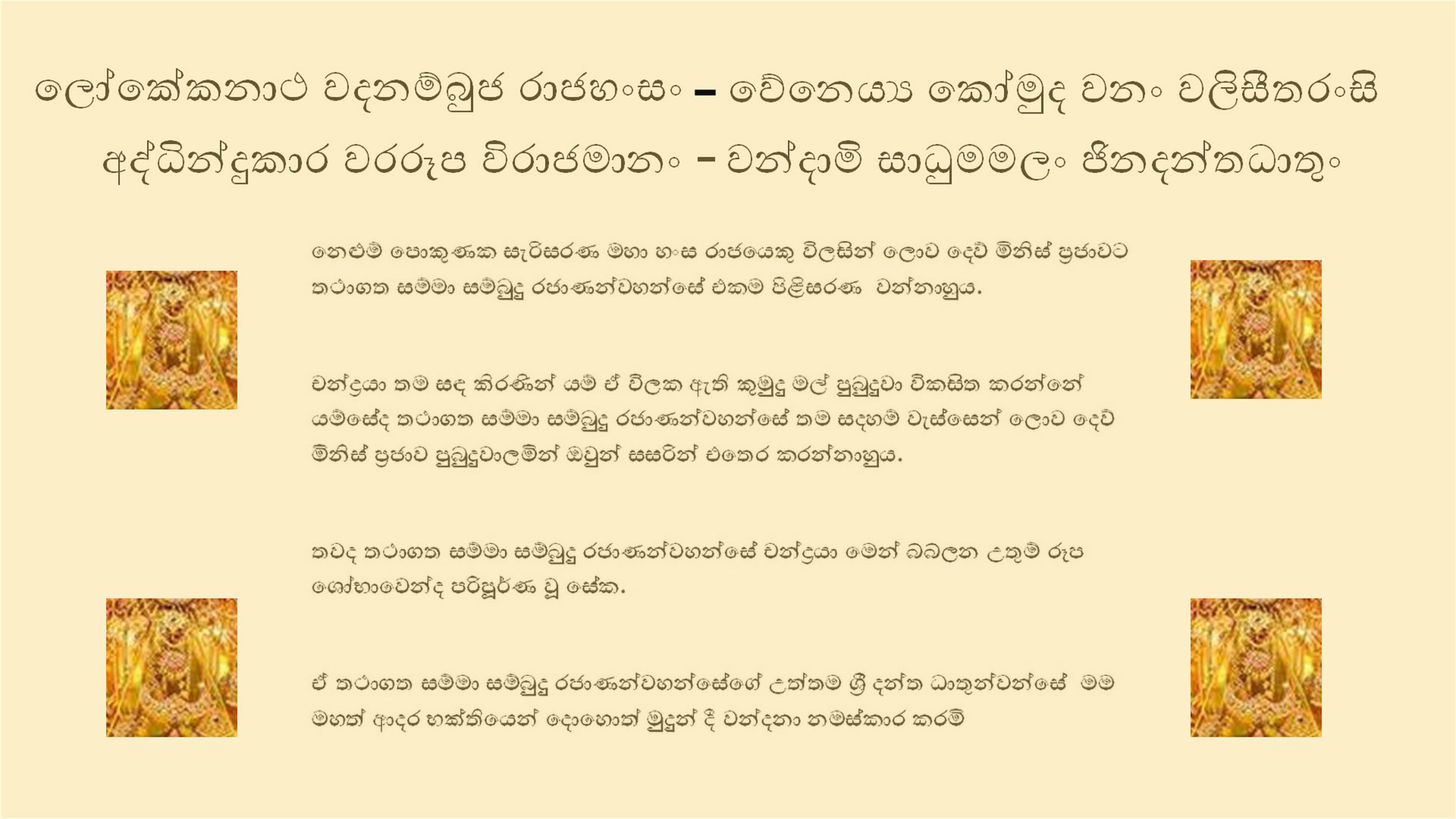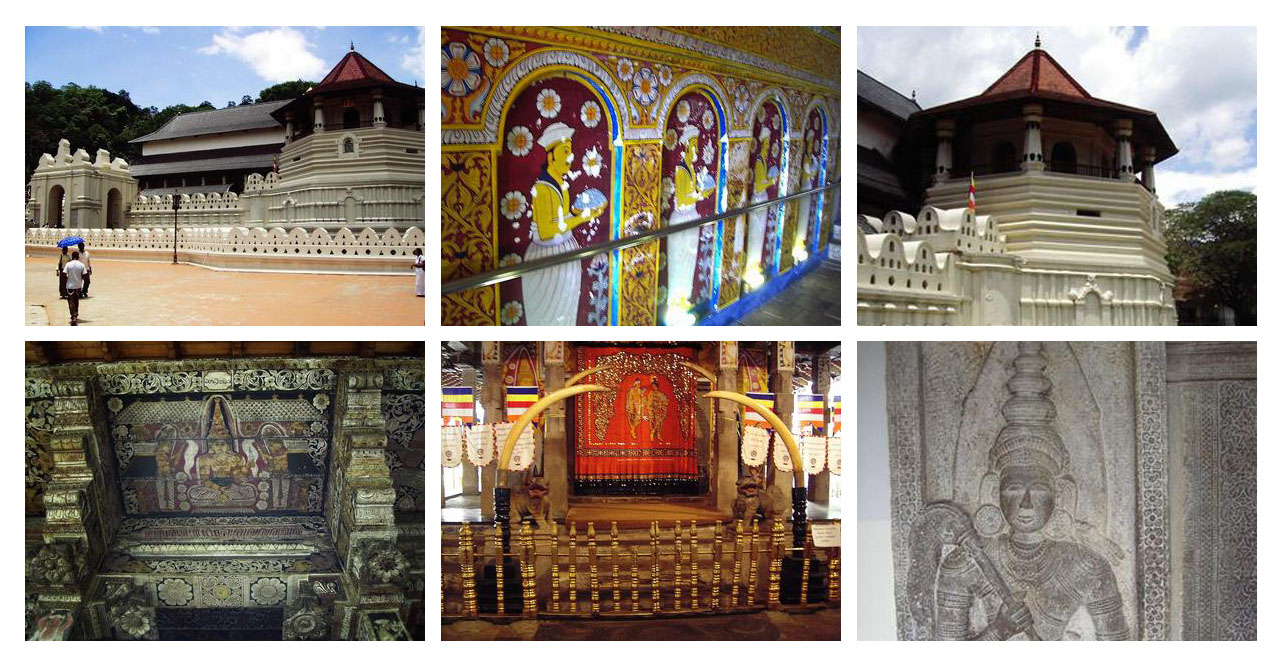Dantha Dhatun Wahanse Wandana Gatha
සිංහල භාෂාවෙන් කියවීමට Navigation Bar හි ගූගල් පරිවර්තකයා භාවිතා කරන්න≈≈≈≈≈≈≈≈≈தமிழ் மொழியில் படிக்க நேவிகேஷன் பாரில் கூகுள் டிரான்ஸ்லேட்டரைப் பயன்படுத்தவும்
Dalada Wahanse Vandana Gatha, Sinhala Lyrics and meaning
Dantha Dhatu Wandana Gatha
Welcome to the Kandy Temple of the Tooth Relic, one of Sri Lanka’s most revered cultural and religious sites. Nestled in the picturesque city of Kandy, this sacred temple houses the most important relic in Buddhism: a tooth of Lord Buddha. Recognized as a UNESCO World Heritage Site, the temple is not only an architectural marvel but also a symbol of the rich history and spiritual heritage of Sri Lanka.
The Temple of the Tooth, or Sri Dalada Maligawa, attracts thousands of pilgrims and visitors each year who come to pay homage and witness the vibrant rituals that celebrate the relic's significance. The temple complex is adorned with intricate carvings, stunning paintings, and tranquil gardens, creating a serene atmosphere for reflection and worship.
As a focal point of Buddhist devotion, the Temple of the Tooth plays a vital role in Sri Lankan culture, hosting numerous festivals and ceremonies, including the famous Esala Perahera. This grand procession, held annually, showcases beautifully adorned elephants, traditional dancers, and musicians, drawing visitors from around the world to experience the vibrant cultural tapestry of Sri Lanka.
Join us as we explore the history, architecture, and significance of the Kandy Temple of the Tooth Relic, a place where spirituality and tradition converge, making it a must-visit destination for anyone seeking to understand the essence of Sri Lanka’s Buddhist heritage.
The Buddha Tooth Relic is a highly venerated object in Buddhism, particularly in Sri Lanka, where it is believed to embody the essence of the Buddha. There is a specific "Buddha Tooth Relic worship stanza" in Pali Sinhala or උත්තම ශ්රී දන්ත ධාතුන්වහන්සේ වන්දනා ගාථාව පාලි සිංහලෙන්.
That is used exclusively by Sinhala Buddhist devotees to venerate the Buddha Tooth Relic. There are various chants and verses used among Buddhist that are recited in reverence to the Buddha and his relics.
One commonly recited stanza in Pali that expresses devotion to the Buddha is:
Namo Tassa Bhagavato Arahato Sammāsambuddhassa
නමෝ තස්ස භගවතෝ අරහතෝ සම්මා සම්බුද්ධස්ස in Pali Sinhala
This translates to:
"Homage to the Blessed One, the Worthy One, the Perfectly Enlightened One."
Worship of the Tooth Relic often includes:
• Chanting: Devotees chant verses and suttas, including those that glorify the Buddha and his teachings.
• Offerings: Common offerings include flowers, incense, and food, symbolizing respect and devotion.
• Ceremonial Processions: Events such as the Esala Perahera feature rituals that honor the Tooth Relic, showcasing its importance in Sri Lankan culture.
These practices reflect the deep reverence for the Tooth Relic and its significance in the spiritual lives of Buddhists.
Dalada Maligawa Perahera Tusker with Perahera Karaduwa


The lower floor of the ancient Tooth Relic Temple inside Maligawa complex

The upper floor of the ancient Tooth Relic Temple where the Lord Buddha Tooth Relic is housed
ශ්රී දන්ත ධාතූන් වහන්සේ වන්දනා කරන ගාථාව -- Sacred Tooth Relic of Gautama Buddha Wandana Gatha lyrics and the Gathawa Sinhala meaning
- ලෝකේකනාථ වදනම්බුජ රාජහංසං
වේනෙය්ය කෝමුද වනං වලිසීතරංසි
අද්ධින්දුකාර වරරූප විරාජමානං
වන්දාමි සාධුමමලං ජිනදන්තධාතුං
ශ්රී දන්ත ධාතූන් වහන්සේ වන්දනා කරන ගාථාවේ තේරුම සිංහලෙන්
නෙළුම් පොකුණක සැරිසරණ මහා හංස රාජයෙකු විලසින් ලෝකයේ දෙව් මිනිස් ප්රජාවට තථාගත සම්මා සම්බුදු රජාණන්වහන්සේ එකම පිළිසරණ වන්නාහුය.
චන්ද්රයා තම සඳ කිරණින් යම් ඒ විලක ඇති කුමුදු මල් පුබුදුවා විකසිත කරන්නේ යම්සේද තථාගත සම්මා සම්බුදු රජාණන්වහන්සේ තම සදහම් වැස්සෙන් ලෝකයේ දෙව් මිනිස් ප්රජාව පුබුදුවාලමින් ඔවුන් සසරින් එතෙර කරන්නාහුය.
තවද තථාගත සම්මා සම්බුදු රජාණන්වහන්සේ චන්ද්රයා මෙන් බබලන උතුම් රූප ශෝභාවෙන්ද පරිපූර්ණ වූ සේක.
ඒ තථාගත සම්මා සම්බුදු රජාණන්වහන්සේගේ උත්තම ශ්රී දන්ත ධාතුන්වන්සේ මම මහත් ආදර භක්තියෙන් දොහොත් මුදුන් දී වන්දනා නමස්කාර කරමි.
Buddha Tooth Relic veneration Stanza ( Wandana Gatha ) in simple English also with Gathawa English meaning
lo-keka-naatha-wada-nam-buja-raaja-han-sam
way-ney-ya-ko-muda-wanam-wali-see-tha-run-see
adh-din-do-kaara-vara-rupa-wiraaja-maa-nam-
van-da-mi-saa-do mama-lan-jina-dan-tha-dha-thuu
The meaning of Tooth Relic veneration Stanza (Wandana Gatha ) in English
Like a majestic swan gliding in a tranquil pond, the Buddha, the Enlightened One, is a source of guidance for both humans and gods in this world.
Just as the moon illuminates to bloom the Water Flake flowers with its gentle rays, the Buddha shares his teachings with all, helping them transcend the vicious cycle of birth and death, known as samsara.
Like the moon's captivating beauty and serenity, the Buddha radiates an unparalleled charm and grace that is truly incomparable.
With profound love and devotion, I humbly worship and venerate the Tooth Relic of the Buddha, the Enlightened One.
way-ney-ya-ko-muda-wanam-wali-see-tha-run-see
adh-din-do-kaara-vara-rupa-wiraaja-maa-nam-
van-da-mi-saa-do mama-lan-jina-dan-tha-dha-thuu
The meaning of Tooth Relic veneration Stanza (Wandana Gatha ) in English
Like a majestic swan gliding in a tranquil pond, the Buddha, the Enlightened One, is a source of guidance for both humans and gods in this world.
Just as the moon illuminates to bloom the Water Flake flowers with its gentle rays, the Buddha shares his teachings with all, helping them transcend the vicious cycle of birth and death, known as samsara.
Like the moon's captivating beauty and serenity, the Buddha radiates an unparalleled charm and grace that is truly incomparable.
With profound love and devotion, I humbly worship and venerate the Tooth Relic of the Buddha, the Enlightened One.

 Sri Dalada Wandana Gatha Lyrics Sinhala meaning pdf
Sri Dalada Wandana Gatha Lyrics Sinhala meaning pdf 
